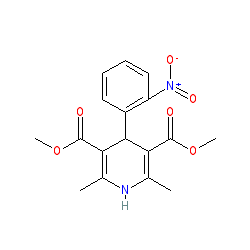GtoPdb is requesting financial support from commercial users. Please see our sustainability page for more information.
|
Synonyms: Adalat® | BAY-A-1040 | Procardia®
nifedipine is an approved drug (FDA (1981))
Compound class:
Synthetic organic
Comment: One of the dihydropyridine class of drugs.
Ligand Activity Visualisation ChartsThese are box plot that provide a unique visualisation, summarising all the activity data for a ligand taken from ChEMBL and GtoPdb across multiple targets and species. Click on a plot to see the median, interquartile range, low and high data points. A value of zero indicates that no data are available. A separate chart is created for each target, and where possible the algorithm tries to merge ChEMBL and GtoPdb targets by matching them on name and UniProt accession, for each available species. However, please note that inconsistency in naming of targets may lead to data for the same target being reported across multiple charts. ✖
View more information in the IUPHAR Pharmacology Education Project: nifedipine |
|
|||||||||||||||||||||||||||||||||||
| References |
|
1. Bertilsson G, Heidrich J, Svensson K, Asman M, Jendeberg L, Sydow-Bäckman M, Ohlsson R, Postlind H, Blomquist P, Berkenstam A. (1998)
Identification of a human nuclear receptor defines a new signaling pathway for CYP3A induction. Proc Natl Acad Sci USA, 95 (21): 12208-13. [PMID:9770465] |
|
2. Grissmer S, Nguyen AN, Aiyar J, Hanson DC, Mather RJ, Gutman GA, Karmilowicz MJ, Auperin DD, Chandy KG. (1994)
Pharmacological characterization of five cloned voltage-gated K+ channels, types Kv1.1, 1.2, 1.3, 1.5, and 3.1, stably expressed in mammalian cell lines. Mol Pharmacol, 45 (6): 1227-34. [PMID:7517498] |
|
3. Guengerich FP, Martin MV, Beaune PH, Kremers P, Wolff T, Waxman DJ. (1986)
Characterization of rat and human liver microsomal cytochrome P-450 forms involved in nifedipine oxidation, a prototype for genetic polymorphism in oxidative drug metabolism. J Biol Chem, 261 (11): 5051-60. [PMID:3514607] |
|
4. Kalman K, Nguyen A, Tseng-Crank J, Dukes ID, Chandy G, Hustad CM, Copeland NG, Jenkins NA, Mohrenweiser H, Brandriff B et al.. (1998)
Genomic organization, chromosomal localization, tissue distribution, and biophysical characterization of a novel mammalian Shaker-related voltage-gated potassium channel, Kv1.7. J Biol Chem, 273 (10): 5851-7. [PMID:9488722] |
|
5. Lamb GD, Walsh T. (1987)
Calcium currents, charge movement and dihydropyridine binding in fast- and slow-twitch muscles of rat and rabbit. J Physiol (Lond.), 393: 595-617. [PMID:2451745] |
|
6. McRory JE, Hamid J, Doering CJ, Garcia E, Parker R, Hamming K, Chen L, Hildebrand M, Beedle AM, Feldcamp L et al.. (2004)
The CACNA1F gene encodes an L-type calcium channel with unique biophysical properties and tissue distribution. J Neurosci, 24 (7): 1707-18. [PMID:14973233] |
|
7. Pignier C, Potreau D. (2000)
Characterization of nifedipine-resistant calcium current in neonatal rat ventricular cardiomyocytes. Am J Physiol Heart Circ Physiol, 279 (5): H2259-68. [PMID:11045961] |
|
8. Pérez-Vizcaíno F, Tamargo J, Hof RP, Rüegg UT. (1993)
Vascular selectivity of seven prototype calcium antagonists: a study at the single cell level. J Cardiovasc Pharmacol, 22 (5): 768-75. [PMID:7506331] |
|
9. Sinnegger-Brauns MJ, Huber IG, Koschak A, Wild C, Obermair GJ, Einzinger U, Hoda JC, Sartori SB, Striessnig J. (2009)
Expression and 1,4-dihydropyridine-binding properties of brain L-type calcium channel isoforms. Mol Pharmacol, 75 (2): 407-14. [PMID:19029287] |








